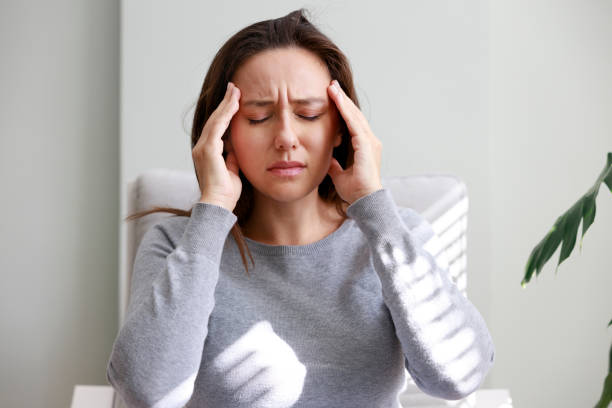Migraines are more than just a headache; they can be debilitating, affecting your daily life. They affect daily activities because the excruciating pain, nausea, and light sensitivity they bring can be debilitating.
Moreover, in addition to prescription drugs, there are many easy-to-follow home remedies and natural ways to ease this condition.
In this article, we’ll explore simple home tips to manage migraine pain effectively.
What Is Migraine?
Beyond the common tension headache, migraine is a neurological headache condition. A pounding torment that generally influences one side of the head is the sign of a migraine, which can wait for a few hours or even days.
Now and again, they are joined by side effects like queasiness, spewing, and an aversion to light and sound.
The Symptoms of Migraine
Prodrome
This is the first stage of migraine, and it can last for hours or days before a headache. The common symptoms of prodrome migraine include:
-
Being sensitive to light, sound, or smell
-
Fatigue
-
Food cravings or lack of appetite
-
Mood changes
-
Yawning
-
Severe thirst
-
Depression
-
Bloating
-
Constipation or diarrhea
-
Irritability
Aura
This is the stage of migraine that are caused by your nervous system and frequently affect your vision. The aura stage can last as long between 5 mins to 60 minutes.
The common symptoms of aura migraine include:
-
Ringing in your ears
-
Changes in taste
-
Temporary loss of sight
-
Numbness
-
Vision loss
-
Arm sensation
Headache
This is another stage of migraine that frequently starts as a dull hurt and develops into pounding torment. It normally deteriorates during your activities.
Usually, it begins on one side of your head and moves to the other, and it can last for almost 72 hours if it is not treated.
The common symptoms of headaches include:
-
Nausea and vomiting
-
Light sensitivity
-
Feeling tired
-
Dizziness
-
Fever
-
Loss of appetite
Postdrome
The postdrome stage goes on for a day or two. The common symptoms of postdrome include:
-
An inability to focus
-
Depression
-
weariness
-
Absence of understanding
-
exuberant disposition
-
Weakness or pain in muscles
The Migraine Causes
Most people believe that certain blood vessel nerves cause migraine headaches by sending pain signals to the brain. Although the primary cause of migraines is still unknown, a number of factors are thought to play a role in their onset, such as:
Genetics: Migraines can run in families.
Brain chemical imbalances: Changes in neurotransmitter levels can trigger migraines.
Hormonal fluctuations: Many women experience migraines related to their menstrual cycle.
Triggers: Certain foods, drinks, and environmental factors can set off a migraine.
The Risk Factors Associated With Migraine
Several risk factors can increase your likelihood of experiencing migraines since someone may not be able to accurately tell who may experience migraines and who may not, yet there are several factors that can make you liable to migraines, which may include:
-
Family background of headaches
-
Gender Ladies are more inclined to headaches than men
-
Age: Headaches frequently start in pre-adulthood and go on through middle age
-
Hormonal changes, like pregnancy or menopause
Types of Migraine
Headaches come in different structures, with probably the most well-known types being:
Migraine with Aura
The unique and sometimes mysterious form of migraine known as “aura” migraine is typified by a pre-headache period.
This aura is usually associated with a variety of sensory disruptions, including visual anomalies like flashing lights, zigzag lines, or blind spots, but it can also include sensory experiences such as tingling or numbness in different body parts.
The aura itself typically passes quickly, but the headache that follows can be excruciatingly painful and incapacitating.
For those who suffer from this kind of migraine, knowing the subtleties of the condition is essential because it can help anticipate and treat the accompanying pain and symptoms.
Migraine without Aura
The most prevalent kind of migraine is typified by moderate to severe headache pain that doesn’t precede other migraine variants’ visual disturbances or sensory changes.
This kind of migraine usually causes severe, throbbing headaches that can last for hours or even days. It also frequently causes other symptoms like light and sound sensitivity and nausea.
It is essential to identify the particular subtype of migraine that a person experiences in order to customize efficient management plans and treatments that will reduce pain and enhance overall quality of life.
Menstrual migraine
Menstrual headache is an unmistakable type of headache that explicitly harmonizes with the hormonal changes in a woman’s menstrual cycle.
These headaches regularly happen on the days paving the way to menstruation and during the initial few days of the menstrual period.
Hormonal variances, especially a drop in estrogen levels, are believed to set off these headaches.
Ladies who experience menstrual migraines frequently battle with extraordinary head pain, alongside other normal headache side effects like queasiness, spewing, and aversion to light and sound.
Abdominal migraine
Abdominal migraine is a lesser-known variant of migraine that predominantly affects children, although it can also manifest in adults.
This unique form of migraine is characterized by recurrent episodes of moderate to severe abdominal pain, often accompanied by symptoms like nausea, vomiting, and a loss of appetite.
Unlike typical migraines that involve head pain, abdominal migraines primarily center their discomfort in the belly.
These episodes can be quite distressing, with the pain often being paroxysmal and pulsating, similar to other migraine types.
Understanding abdominal migraines is crucial, especially for parents and healthcare providers, as it aids in early diagnosis and effective management strategies, which may include dietary changes and stress reduction techniques.
Hemiplegic migraine
Hemiplegic migraine stands out among the diverse spectrum of migraines due to its distinct and dramatic symptoms.
Individuals experiencing a hemiplegic migraine may endure not only the usual throbbing head pain but also temporary paralysis or weakness on one side of their body (hemiplegia).
These episodes often present with other symptoms akin to those of a stroke, such as confusion, difficulty speaking, and visual disturbances.
Hemiplegic migraines can be frightening and are often challenging to distinguish from other medical emergencies.
Chronic migraine
Chronic migraine is a continuous battle against debilitating headaches, with individuals experiencing headaches at least 15 days per month. It’s an ongoing pattern of discomfort that affects daily life.
Chronic migraines frequently necessitate a multifaceted approach that includes lifestyle changes, preventive medications, and a keen awareness of triggers.
Seeking professional help is critical for those suffering from this chronic condition.
Vestibular migraine
Vestibular migraine is a subtype that adds a dizzying twist to the typical migraine experience. People living with this condition often contend with intense vertigo, imbalance, and nausea during their migraine attacks.
It’s like a rollercoaster of sensory disruptions that can be quite challenging to navigate.
An effective management strategy for vestibular migraines involves identifying triggers and collaborating closely with physicians.
What Triggers Migraine
Identifying and avoiding triggers is crucial in managing migraine.
Common triggers include:
-
Certain foods and drinks (alcohol, aged cheeses)
-
Environmental factors (bright lights, loud noises)
-
Stress
-
Tobacco
-
Too much caffeine
-
Hormonal changes
-
Weather changes
-
Lack of sleep
-
Skipping meals
-
Vasolidator drugs
Simple Home Tips to Manage Migraine Pain
Simple home tips to manage migraine pain. By following these suggestions, you can lessen the frequency and intensity of your migraines and find relief.
-
Putting a cool compress or ice pack on your forehead
-
Apply a cold compress to your forehead or the back of your neck for relief during a migraine attack.
-
Stay Hydrated
-
Maintain a Migraine Diary
-
Eat regular balanced meals
-
Resting in a dark, quiet room with your eyes closed
-
Avoid excessive caffeine
-
Consult with a healthcare professional about adding magnesium supplements to your diet
-
Practice relaxation techniques like deep breathing, meditation, or yoga.
When to See a Doctor
Though simple home tips can be effective, nonetheless, there are situations where you should seek medical attention:
-
When the frequency and intensity of your migraines increase
-
At a point when using over-the-counter painkillers is ineffective.
-
If you experience neurological symptoms, such as difficulty speaking or weakness.
-
If your migraine is accompanied by a high fever.






